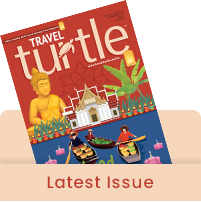Step into Dubai, and you don’t just arrive—you awaken. This is not just a city of steel and sand; it’s a living canvas of dreams woven together with gold threads of ambition, culture, and innovation. Bader Ali Habib, Director of Proximity Markets, Dubai Department of Economy and Tourism shares plans for the year 2025 and beyond.
Tripti Jain
Skyscrapers in Dubai just don’t pierce the sky—they challenge gravity. Malls aren’t just places to shop—they’re sensory palaces. And every street corner tells a story—one where luxury coexists with legacy, and tomorrow is always one sunrise closer.
In 2025, Dubai is not waiting to impress you. It’s inviting you to belong. Bader shares, “This year is more than a milestone. It’s the moment we go from being a place people visit… to a place they return to—mentally, emotionally, culturally.”
From milestones to movements
After welcoming 18.72 million international overnight visitors in 2024, Dubai could’ve paused for applause. But instead, it pushed forward. 2025 isn’t about outdoing numbers—it’s about outdoing expectations.
Bader highlights the D33 idea and explains, “2024 was a great year, but now, with D33—Dubai’s Economic Agenda to double the economy in a decade—we’re thinking in movements, not just milestones.”
Every new development, from the expansion of Hatta to upcoming mega projects such as Palm Jebel Ali, is a piece in a much bigger puzzle: transforming Dubai into one of the world’s top 3 global cities and tourists are not just spectators—they’re co-authors in this story.
Personas over passports
Gone are the days when travellers were grouped by nationality. In 2025, Dubai is designing experiences for emotions, personalities, and desires. “We’re not just asking where our visitors come from—we’re asking why they come. Whether it’s the Indian mother looking for child-friendly experiences or a Gen Z traveller searching for Instagrammable spots—we’re catering to personas, not profiles,” says Bader.
Nowhere is this more evident than in Dubai’s evolving India strategy. The bond with India is more familial than formal. Bader smiles and shares, “It’s not just business. It’s a relationship we deeply value and nurture.”
This year, South India takes center stage, with curated campaigns tailored to its unique culture, languages, and aspirations. He adds, “We’ve never gone this deep into the nuances before, but that’s where magic happens—in the details.”
From roadshows to real conversations
In a world drowning in information, Dubai is choosing connection over promotion. The traditional roadshow model is being replaced with immersive training, workshops, and hands-on destination education. Bader shares, “In India, many think they know Dubai—but in truth, they’ve only scratched the surface, we’re changing that.”
In 2024, the city hosted 1,800 Indian travel agents across sessions in cities such as Surat and Goa, emphasising local outreach and learning. He explains, “When people discover things such as the Coffee Museum or the architectural wonder of Al Seef, their perception shifts instantly. It’s not about selling a package—it’s about sharing a story.”
Luxe is evolving
Luxury in Dubai isn’t just about chandeliers or penthouses anymore. It’s a multi-sensory experience—curated for meaning, not just money. Bader points, “Indian travellers are evolving, they want depth, they want distinction—and we’re delivering that.”
From ocean-view suites at Atlantis The Royal to heritage-inspired stays in Old Dubai, from Michelin-starred Indian chefs in DIFC to Gaurav Gupta’s fashion spectacle at the Museum of the Future—Dubai is painting a new picture of indulgence.
He shares, “Gupta didn’t just showcase fashion, he captured our soul—by exploring, by understanding, and by merging Indian elegance with Dubai’s modernity.”
The world’s easiest yes!
With Dubai’s visa-on-arrival facility for Indians holding select international visas, access has never been easier. But more than logistics, it’s about emotional convenience. “It empowers families, solo travellers, NRIs—it tells them: You’re welcome here, always,” says Bader.
The result is a rise in stopover tourism, shorter family getaways, and multiple trips in a year. “We’re not aiming for longer stays—we’re aiming for deeper connections,” he adds.
Listening to Gen Z
Young Indians aren’t just influencing travel—they’re leading it. Bader emphasises on the fact and shares, “The Gen Z traveller is curious, digital-first, and deeply experiential. They shape family decisions. They know what’s trending. And they demand authenticity.”
Dubai has responded with new-age experiences—from gaming arenas and e-sports zones to House of Hype, an immersive social media playground. He adds, “This generation doesn’t just want to see Dubai. They want to live it—and share it in real time.”
Culture on the Catwalk
In 2025, Dubai is India’s global playground. From Ranveer Singh shooting in the deserts to Indian wedding planners filling up Dubai’s palaces, from sari boutiques in Al Karama to Bollywood beats at music festivals—there’s a cultural duet at play.
Bader says, “Fashion, food, music—it’s all blending beautifully. We’ve moved past collaboration. We’re in celebration. Initiatives such as the India by Dubai campaign and luxury designer showcases are not just about promoting art—they’re about living it together.”
Still dreaming, still building
Even with global achievements, Dubai isn’t done dreaming. Projects such as Therme Dubai (the world’s largest wellness resort) and new beachfront communities will redefine what a city can be.
Bader shares, “We’re still building—not because we’re incomplete, but because we believe in better. Our future isn’t a plan. It’s a promise and with sustainability now embedded in hotel certifications, infrastructure planning, and D33 mandates, Dubai is shaping a tomorrow that respects the planet just as much as its people.”
The destination that knows you!
In 2025, Dubai isn’t merely welcoming the world. It’s listening to it, learning from it, and growing with it. With India, the relationship is heartfelt, historic, and only just beginning a new chapter. Bader says, “Dubai doesn’t just want to be seen—it wants to be understood, and in return, it understands you. This isn’t just tourism, its trust. We’re building it—experience by experience, family by family, dream by dream.”



